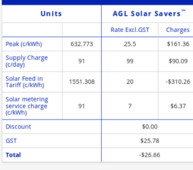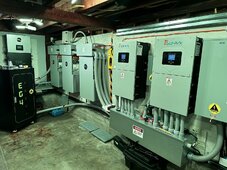wheisenburg
Independent Solar Consultant
I have a grid tied system with full net metering. So for me, yes I do have an electric drier and I have no plans to replace it. Driers along with water heaters are energy pigs. Now your situation in Phoenix is better than mine. You are farther south and there are very few long periods of cloudy days. In Louisiana the situation is probably somewhere between us. Because this is a fully OFF GRID system, just pulling a few KWHs from the grid to dry a load of laundry is not an option. Putting off laundry for a week because it is cloudy may not be an option either. For someone trying to live a normal life in an off grid home, running out of power because you needed to do laundry really isn't an option either.IMNSHO if you are going solar, I'd go all the way electric and only run propane/other as a last resort. $500-$1000 for a gas appliance. $1500 for another 25A inverter to meet demand. The battery is the big deal, but even though the thing really uses juice, I'd roll it and plan for some extra battery. Panels are cheap. The idea is to not pay the Gas company or the Power company.
My situation is different. With full net metering I can push power to the GRID during the day and pull it back later for free. My batteries are there just to get me through power failures without extreme inconvenience. If we get a longer outage during the winter when my PV generation is consistently less than consumption, I will need to run a portable generator once or twice a day to top the batteries off. Yes pulling out and hooking up a portable generator is a pain, but this works for me. It is a situation I can live with if I have to in the event of a power failure at the worst possible time. I don't think this is acceptable for someone fully off grid.
For someone fully off grid and just looking for a feasible system, I think what makes the most sense is to design the system such that it can supply your house 95% of the days. Then supplement that with a generator about 15 days a year. Getting to that 95% is going to be significantly cheaper if the overall load on the system is less, so reducing overall consumption is part of the solution. This is especially true with batteries. I would make sure the system has plenty of KWs of inverter capacity, especially surge current if driving a well. For battery storage, I would make sure I had 1 day of storage for a winter day, and maybe a little more to make sure I can run A/C after we lose PV production in the evening. In summer you get better PV production and if it is cloudy A/C consumption also drops, so I wouldn't size this for one day of the highest energy use. Let's say we go with 30 KWHs of storage and that gets us through 95% of days without needing the generator. If you have sized the system to meet the power requirements 95% of the days, you will run the generator 15 days a year.
Now lets say that instead we double our storage to 60 KWH. That might cover us for 98% of the days. We would still need to run the generator about 6 days a year. So doubling storage will cost us about $9000 and save us from 9 days of generator use.
The cost of generating 1 KWH on a natural gas generator is about $0.20. The cost of storing 1 KWH in a battery is about $300.00. Yes the battery can be used more than once, but you won't break even until you have completed 1500 cycles. It will take you more than 150 years to recover the cost. My idea is to not pay more overall for a comfortable off grid life style.
Now if the system is undersized, the only down side is that the generator will run more than you planned. Based on experience, you could add either more solar or more storage depending on where the system is falling short. Adding more panels and possibly a charge controller or more batteries shouldn't be a big deal.





